|
|
| HEALTHY HAPPENINGS - July 2025 |
“I Think I Have Candida”
by Ray Andrew, MD |
In 2008, I was sitting across the table from Janet as she listed one physical complaint after another: fatigue, brain fog, insomnia, sugar cravings, feeling sick all over, headaches, depression, constipation, muscle aches, weight gain, bloating, irritability, heartburn, rectal itching, PMS…Good grief! During my training, some doctors called patients like Janet “train wrecks” because they had so many problems that the doctors didn’t know where to begin. Others called them “the worried well” because they looked just fine on the outside, didn’t have any diagnosable disease, and their routine labs were all normal.
As Janet elaborated on one symptom after another, I thought about the drugs I was taught to prescribe for each. Some symptoms were easy to cover up with over-the-counter or prescription medicines. With others, my medicine toolbox came up short. There is no drug to control sugar cravings or clear up brain fog, for example.
When she finished telling me all her problems, Janet surprised me by announcing, “I think I have Can-‘dee-da.” I did my best to contain my contempt toward the suggestion. I had known, respected, and cared for Janet for several years now, but she had obviously been spending way too much time on the internet. In all my years of studying and practicing medicine, I had never seen anyone with Candida walking around and looking as good as she did. “If you had Candida,” I informed her, mustering all the respect I could for someone who had been so duped, “you would be in an ICU fighting for your life.”
Shortly thereafter, Janet moved away. As I continued my study of what later became the specialty of Functional Medicine, I wished I could have rewound the clock. I would tell Janet, “Uh, sorry, but you were right. And now I know how to treat your problem.”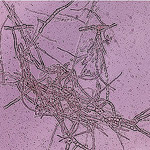
Years later, I still treat—on a daily basis, no less—what I did not even know existed back in 2008. I used to think it was something some do-it-yourself health freak on the Internet made up. In training, doctors learned about women getting vaginal Candidiasis, babies getting thrush, immunosuppressed people getting fungal pneumonia, and really sick people getting yeast in their bloodstreams requiring urgent life-saving intravenous antifungal therapy. Ironically, we were never taught to recognize, and much less to treat, the yeast condition that is hands-down far more common than any of these: yeast overgrowth, which lay people often simply call “Candida”.
We don’t “catch” yeast like we do a cold or Strep throat. Technically, yeast don’t “infect” us like other microorganisms do. Yeast are all around us and in us. They are found on our skin, in our sinuses, in vaginas, and all along the gastrointestinal tract. They live in harmony with numerous bacteria and viruses in each of these places. As long as yeast are kept in check by these other organisms, they don’t cause any trouble. When yeast get out of hand, that’s when health and quality of life suffer. You might say it’s like a lush green lawn being overtaken by weeds. As long as the lawn is well cared for and healthy, weeds don’t cause any trouble. When grass dies for any reason, weeds are more than happy to take over.
How does this happen? Sadly enough, it’s actually the simple and predictable result of modern medicine and the Standard American Diet (S.A.D.). All it takes is a single dose of an antibiotic to disrupt the normal ecosystem of the body. Yes, antibiotics can be lifesaving, but they kill good bacteria just as well as—if not better than—bad bacteria. The “good” bacteria—otherwise known as “commensal” bacteria—are critical to human health. Commensal bacteria help the immune system recognize threats. They keep “bad” bacteria and yeast from getting out of hand. They keep us from accumulating unhealthy fat. And they produce certain vitamins, fatty acids (which feed the intestines), and enzymes (for hormonal balance). All of this and more depends on strong populations of numerous different types of commensal bacteria.
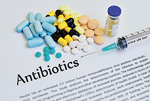
A dose of antibiotics can be devastating to this balance. Once yeast and unhealthy bacteria overgrow, the disruption is permanent. Commensal bacteria don’t magically grow back and take back their previous territory, no matter how many years go by. But antibiotics aren’t the only culprit. Add to this the steroids doctors prescribe for rashes, asthma, allergies, autoimmune diseases, and other conditions. Yeast just love steroids. They also love sugar, their favorite food. Never in history has sugar been so readily available, cheap, and such a ubiquitous part of the human diet as it is now. Add stress to the mix of antibiotics, steroids, and sugar and we have the perfect storm for yeast overgrowth. With the deck stacked so strongly against us, it’s a wonder everyone doesn’t suffer from this condition.
Fortunately, we can win this battle. The first step is to recognize the problem. Rather than viewing a handful of symptoms as separate problems, we have to recognize that they all stem from the same underlying imbalance. When a woman develops a vaginal yeast “infection”, she’s not going to be happy until she kills the yeast in her vagina with an antifungal pill or cream. But then she needs to treat the overgrowth in her intestines to keep the problem from recurring. When someone has a case of bacterial sinusitis, he needs to undergo treatment of the yeast in his sinuses so the bacterial infection does not come back.
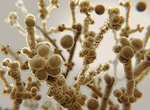
One problem we have with yeast overgrowth is that it is impractical to prove its presence. It’s not a disease, and current testing methods have poor sensitivity. We can’t go around biopsying intestines and sinuses to quantify the different populations of microorganisms. It’s impractical. And cultures are notoriously inaccurate, particularly because yeast adhere to mucosal surfaces and therefore don’t often show up in cultures. So we are left with relying on known patterns of dysfunction caused by yeast overgrowth. Biofeedback can also be helpful in suggesting the presence of this imbalance. We can also obtain some level of confidence in our suspicion simply by treating the problem and observing whether all the related symptoms resolve.
Another problem with yeast overgrowth is the difficulty of treating it. The 20th century approach to health and disease promoted by John D. Rockefeller and his associates has conditioned Americans to expect that a magic pill from a chemical factory can fix—or at least control—whatever ails us. Unfortunately, it’s not so easy. Treatment requires understanding what caused the problem and how it is affecting the landscape of the human body. It requires a multifaceted approach since yeast are quite hearty organisms. They do not go away without a fight. And lifestyle change is often necessary in order to prevent recurrence. At Prestige Wellness Institute, we utilize an approach that simultaneously starves yeast, crowds them out, removes barriers yeast use to protect themselves, restores the microbial balance in the body, and targets key functions in the cells that are necessary for them to survive.
Following this approach, countless people have discovered they can enjoy better health. For example, Jim exclaimed, “If I had known about this 12 years ago, I never would’ve undergone sinus surgery. I felt great for a month and then all my symptoms came back. Now they’re completely gone!” Jenna noted, “I thought I needed Ozempic, but it turns out what I really needed was to treat my yeast.” Jacob sheepishly asked, “Can this affect sex drive? Ever since I started your protocol, my libido went through the roof!” Terri’s heartburn and stuffy nose went away, so she was able to stop taking the decongestants and the purple pill she thought she was stuck with for life.
If you suspect you have yeast overgrowth, or have annoying symptoms you just can’t find answers for, call Prestige Wellness Institute at (435) 259-4466 in Moab or (435) 210-0184 in Utah County.
|
Confirmed Measles Case in Utah: What You Need to Know
by Hospital Staff
|

Moab Regional Hospital is sharing an important health update: As of June 20, Utah public health officials have confirmed a case of measles in an unvaccinated adult from Utah County. This person had no out-of-state travel, which means the virus was likely spread within Utah. While no other cases have been confirmed, we’re taking early, proactive steps—guided by the Utah Department of Health and Human Services (UDHHS)—to help protect our patients, staff, and the wider community.
Why This Matters
In Moab and other rural areas, summer brings more than just sunshine—it brings an influx of visitors and increased travel, which can raise the risk of spreading illnesses like measles. That’s why it’s important to stay alert and take simple precautions to keep your family and neighbors safe.
What Is Measles?
Measles is a serious and highly contagious disease caused by a virus. It spreads through the air when an infected person coughs or sneezes, and the virus can linger in the air for up to two hours. If you’re not vaccinated, there’s a 90% chance you’ll catch it if you’re exposed.
Why Measles Can Be Dangerous
Measles is more than just a rash and a fever. It can lead to serious complications, especially for young children, infants, and people with weakened immune systems. Complications can include:
• Pneumonia
• Swelling of the brain (encephalitis)
• Hospitalization or even death
Symptoms to Watch For
Symptoms usually appear 7–14 days after exposure and may include:
• High fever (sometimes over 104°F)
• Cough
• Runny nose
• Red, watery eyes
• A rash that starts on the face and spreads to the rest of the body
How to Protect Yourself and Others
The best protection against measles is the MMR vaccine (measles, mumps, and rubella). It’s a safe and effective vaccine recommended for all children, typically administered between 12 and 15 months of age, with a second dose given between 4 and 6 years of age. It’s widely available, and if you or your child hasn’t been vaccinated, it’s not too late.
Vaccines are available at Moab Regional Hospital (Family Medicine Clinic), Southeast Utah Health Department, and other local
clinics.
What to Do if You Think You’ve Been Exposed
If you or someone in your household shows symptoms of measles: Call your doctor, an Urgent Care Facility, or the emergency room before arriving in person. This helps prevent exposing others and gives healthcare staff time to prepare for your safe care.
A Reminder for Our Community
In a small, close-knit place like Moab, we all have a crucial role to play in keeping each other safe, especially with so many travelers passing through. Now’s the time to double-check your vaccine status and help spread awareness, not illness. Your actions can make a significant difference in preventing the spread of measles in our community.
Have Questions?
If you have any questions or need more information, don’t hesitate to contact your healthcare provider, the Family Medicine Clinic at Moab Regional Hospital (435-719-5500), or the Southeast Utah Health Department (435-259-5602). They are there to support you and provide you with the information you need to stay safe and healthy.
Additional Information:
Utah Department of Health & Human Services: epi.utah.gov/measles-response/
Centers for Disease Control & Prevention: www.cdc.gov/measles/data-research/index.html
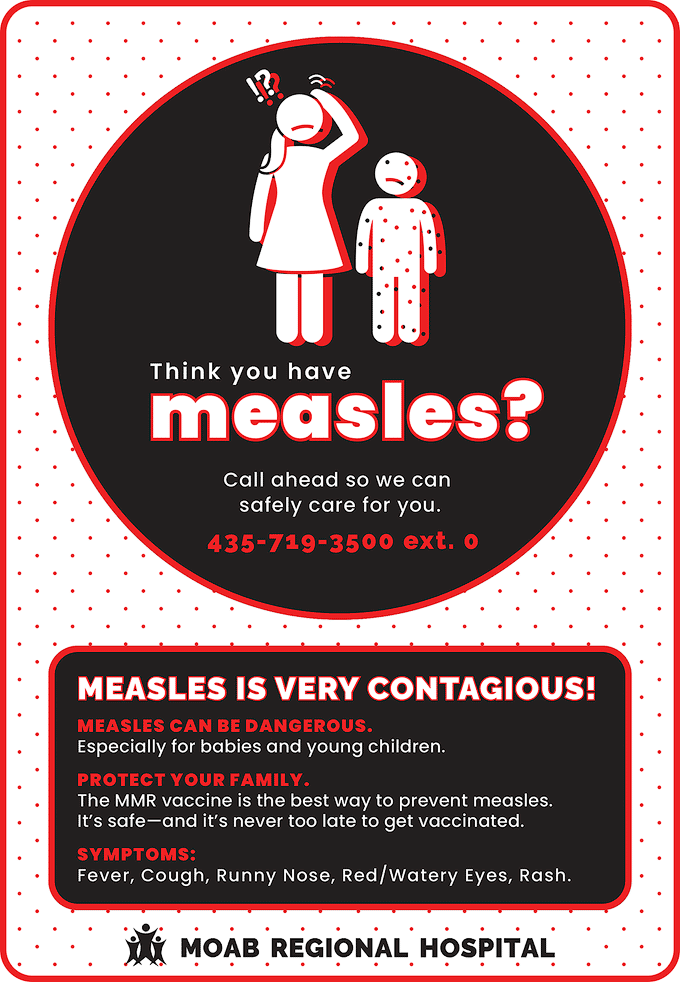
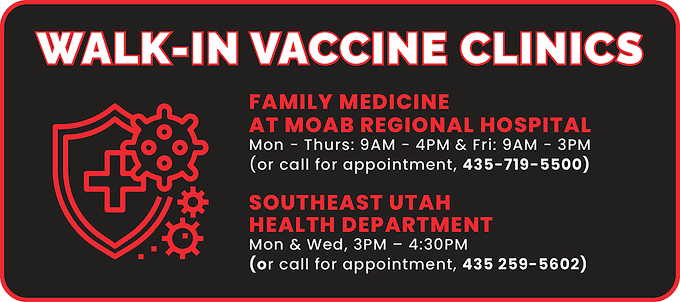
|
| Exhibition: Healing Nature of Landscape |

The Art Center of Western Colorado and Community Hospital are proud to announce a collaborative exhibition—Healing Nature of Landscape. The exhibit will be on display throughout the main hallway at Community Hospital, located at 2351 G Road, in Grand Junction, CO through Thursday, July 31.
Artwork evokes a range of emotions that can significantly impact a person’s health and well- being, uplifting the spirit and lightening the mood. It can encourage, enrich, and even deepen the soul. These qualities assist in the healing process and strengthen individuals during times of adversity. Thus, artists can play a unique role in the health of individuals.
The goal of the art exhibition at Community Hospital is to bring the natural beauty of western Colorado (in the form of landscape art) to the hospital. The Healing Nature of Landscape exhibit will feature twelve pieces created by local artists, including Phillip Carlton, Loren Eakins, Cynthia Duff, Cedar Keshet, Monica Esposito Mann, and others.
“We are incredibly honored to host this art exhibit in partnership with The Art Center of Western Colorado,” said Karen Martsolf, Chief Marketing/Communications Officer and Foundation Director for Community Hospital. “Our goal is to create a health care environment personalized to each patient that focuses on health and wellness. Hosting an art exhibit that features the extraordinary talent of local artists is a wonderful way to foster a comfortable and healing environment for our patients, visitors, and staff.”
“Our mission is to promote art in our community,” said Peter Booth, Advancement Director for The Art Center. “Community Hospital has given us this incredible opportunity to take this mission into their facility. We are so excited that this art will beneficially impact the lives of those in need.”
The artworks displayed will be available for purchase, with the proceeds benefiting the Community Hospital Foundation.
The Art Center of Western Colorado’s mission is to enrich lives by promoting the enjoyment and understanding of the arts.
Community Hospital’s mission is to improve the health and quality of life of the individuals and communities we serve.
|
|
|
|
|
|
|
|
|
|
© 2002-2025 Moab Happenings. All rights
reserved.
Reproduction of information contained in this site is
expressly prohibited.
|
|